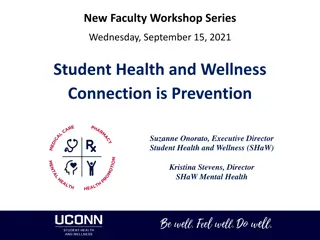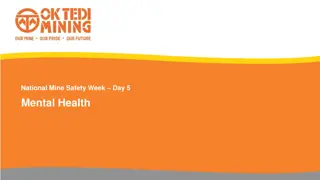Understanding Mental Health Education and Support
Explore the importance of mental health education through activities like reviewing case scenarios, card sorting, and understanding the mental health continuum. Learn about common mental health problems and their signs, including mood disorders, anxiety disorders, disordered eating, suicidal ideation, and substance-related disorders. Gain insights into depressive disorders and their signs and symptoms. Discover how to support individuals with mental health problems effectively.
Download Presentation

Please find below an Image/Link to download the presentation.
The content on the website is provided AS IS for your information and personal use only. It may not be sold, licensed, or shared on other websites without obtaining consent from the author. Download presentation by click this link. If you encounter any issues during the download, it is possible that the publisher has removed the file from their server.
E N D
Presentation Transcript
MENTAL HEALTH EDUCATION Dr. Mike Condra condram@queenus.ca Queen s University
Agenda 1. Mental Health Continuum Review + Activity 2. How You Can Support a Person with a Mental Health Problem 3. Signs of Common Mental Health Problems
What is Mental Health? A state of successful performance of mental functions, resulting in: Productive and/or meaningful activities Fulfilling relationships Ability to adapt, change, and cope with adversity WE ARE CONTENT AND WE CAN DEAL WITH STRESSES
Mental Health Continuum Mild Moderate Disruption Severe Disruption Healthy Disruption
Mental Health Continuum People experience mental health problems differently People can move along the continuum There is overlap between zones
Review: Case Scenarios In your small group, review the handout ( Case Scenarios ) and look at the continuum. Discuss the following questions with your group: Identify where the individual is on the mental health continuum. Explain the rationale for your choice. What could you do to help this individual?
Card Sorting Activity Cards will be distributed that have terms printed on them that are often used to describe a person s mental health. Place your card where you think it belongs on the continuum between healthy and severe disruption. Be prepared to explain the rationale for your placement.
A Quick Re-Cap of Mental Health Problems 1. Mood Disorders 2. Anxiety Disorders 3. Disordered Eating and Eating Disorders 4. Suicidal Ideation 5. Substance-Related Disorders
Depressive Disorders Signs and Symptoms Thinking Behaviour Crying Spells Withdrawal Neglect of Personal Appearance Lack of Motivation Self-Criticism Physical Lack of Energy Sleeping Too Much/Little Weight Loss/Gain Emotions Sadness Thoughts of Suicide Mood Swings Hopelessness Anxiety Indecisiveness Pessimism Loss of Hope
Signs of Suicidal Ideation Sense of lack of control Loss of hope Lack of sense of a viable future The Three I s Psychological pain that is Inescapable Interminable Intolerable
Bipolar Disorders Signs and Symptoms Manic/Hypomanic Symptoms Dramatically Increased Energy Depressive Symptoms Elevated Mood Reduced Need for Sleep Irritability Rapid Thinking and Speech Lack of Inhibitions Lack of Insight
Anxiety Disorders Signs and Symptoms Physical Heart Rate Tiredness Sweating Emotions Nervous Powerless Sense of Impending Doom Thinking Difficulty Concentrating Unwanted Recurrent Thoughts Behaviour Repetitive Behaviours Trembling Rapid Breathing
Disordered Eating and Eating Disorders Anorexia Bulimia Binge Eating
Eating Disorders Signs and Symptoms Behaviour Skipping meals Excuses for not eating Eating only safe foods Rigid diet Not wanting to eat in public Eating large amounts of high fat or sweet foods Use of over-the-counter weight loss pills or laxatives Leaving meals to go to the bathroom Eating in secret Thoughts Distorted body image Low self-esteem Emotions Intense fear of becoming fat or of weight gain Feeling of being out-of-control Depression Physical Signs Wearing baggy clothes Excessive exercise Thin or overweight appearance Difficulty sleeping (too much/little)
Substance-Related Disorders Types of Substances Alcohol Prescription Drugs Over the Counter Drugs/Substances (solvents, glues or aerosols) Illegal Drugs Signs of a Substance Use Problem Increasing frequency and/or amount Increased reliance on substance to cope with new situations Memory lapses Increased socializing with people who use Lying about use Difficulty to meeting role expectations/obligations Financial problems Increased risky behaviours
Adapting Your Approach What are three things a Peer Mentor could do to adapt their mentoring approach when working with a student who appears or shows: Low mood, low energy ( I m so tired. I don t think I can do it. Why bother? I m a failure. ) Visibly anxious, difficulty concentrating ( I m so stressed I can t think clearly. ) Low self-esteem, highly self-critical ( It has to be perfect or I can t hand it in. ) Remember: Goal is not diagnosis, but rather being mindful of your own mentoring approach (YOUR behaviour, words, energy level, body language)
How You Can Help A L S R Approach Listen Support Refer
ALSR Attentively Non- Judgementally Reach out; Talk to them when you are calm and have time Listen Approach Give reassurance and comfort. Give advice only when asked. Help them find resources and encourage use. Support Refer
Techniques Say what you see focus on behaviour Avoid assumptions, using labels or offering a diagnosis Try to talk to the person at a good time in a quiet and private environment Examples I ve noticed that you have missed some of our appointments and I m concerned You don t seem like yourself lately. How are you doing? You seem down. Are you feeling OK? Approach
Techniques Active listening; summarizing and clarifying statements Provide the opportunity for the person to vent; only speak when the person is finished Don t offer personal judgements about what the person is feeling Minimize distractions Be present Examples Is there anything I can do to help? It sounds like you re feeling.. (reflect listening, paraphrase Mentee) That sounds difficult to deal with Listen
Techniques Offer hope and affirm the likelihood that things will get better Show that you are there and want to help Offer perspective; Offer empathy not sympathy Examples: I am glad that you ve told me this Although you are feeling this way now, it doesn t mean that you will feel this way forever. Things can get better You are not alone Support
Techniques Point out that help is available and affirm self- disclosure and help-seeking as signs of strength/courage Make a plan; offer to stay with the person while they contact the resource and to follow-up if needed If the person refuses the referral, respect their decision; you cannot force a person to get help unless it is an emergency situation Examples Have you thought about talking to someone about this? I know of some good resources Help is available Refer
Applying the ALSR model Case #1 You have been meeting with your Mentee for 8 weeks. Tracey typically arrives on time and actively contributes to the meetings, which have largely focused on exploring positive coping techniques for exam and testing anxiety. She has been late for the past two meetings, and seems visibly anxious about her upcoming midterm. Discussion: 1. Where is Tracey on the Mental Health Continuum? 2. How would you apply the ALSR model? 3. How would you adapt your mentoring approach based on the signs or cues you notice in Tracey?
Applying the ALSR model - Case #2 During the last 2 weeks you have noticed some marked changes in Danika s behaviour and appearance. She seems very tired and quite withdrawn. She answers many of your questions with one- word responses; this is a marked change from her typical behaviour. She also seems to be much less engaged and responsive to your suggestions. She has also not been following through with her homework commitments. At today s meeting, Danika becomes visibly upset and tearful for no apparent reason. Discussion: 1. Where is Danika on the Mental Health Continuum? 2. How would you apply the ALSR model? 3. How would you adapt your mentoring approach based on the signs or cues you notice in Danika?
Recap and Questions Mental health is on a continuum, and we can range from a healthy zone to a severe disruption Supporting someone with a mental health disorder involves a four-step process: Approach, Listen, Support, Refer Questions?























